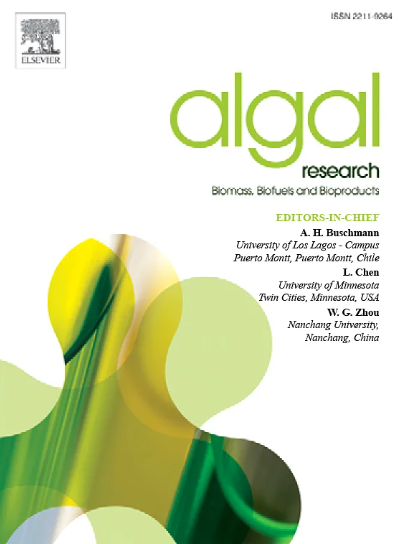Engineering a complete mevalonate pathway in Chlamydomonas reinhardtii for enhanced isoprenoid production
IF 4.6
2区 生物学
Q1 BIOTECHNOLOGY & APPLIED MICROBIOLOGY
Algal Research-Biomass Biofuels and Bioproducts
Pub Date : 2025-03-09
DOI:10.1016/j.algal.2025.103987
引用次数: 0
Abstract
Isoprenoids are a diverse class of natural compounds with significant industrial applications. While microbial production offers advantages, limitations arise from the absence of the mevalonate (MVA) pathway in many high-yield hosts. Here, we report the successful construction of a complete and functional MVA pathway in the eukaryotic microalga Chlamydomonas reinhardtii, a model organism with high photosynthetic efficiency and simple growth requirements. Employing a two-step transformation strategy and optimized gene expression cassettes, we achieved robust expression of both upstream and downstream MVA pathway enzymes. Notably, the introduction of the upstream module alone led to a dramatic seven-fold increase in isopentenyl pyrophosphate (IPP) levels, while co-expression of the complete pathway resulted in a 50 % increase in total carotenoid production. Transcriptomic analysis revealed significant upregulation of genes involved in carotenoid biosynthesis, confirming the redirection of metabolic flux towards terpenoid synthesis. Our findings demonstrate that a strategically engineered MVA pathway can overcome inherent limitations in C. reinhardtii metabolism, establishing this microalga as a powerful platform for the efficient, scalable production of diverse isoprenoids and other high-value compounds.
异戊烯类化合物是一类种类繁多的天然化合物,具有重要的工业用途。虽然微生物生产具有优势,但由于许多高产宿主缺乏甲羟戊酸(MVA)途径而受到限制。在此,我们报告了在真核微藻莱茵衣藻(Chlamydomonas reinhardtii)中成功构建了完整的功能性甲羟戊酸(MVA)途径,莱茵衣藻是一种具有高光合效率和简单生长要求的模式生物。我们采用两步转化策略和优化的基因表达盒,实现了 MVA 途径上游和下游酶的稳健表达。值得注意的是,单独引入上游模块可使焦磷酸异戊烯酯(IPP)水平大幅提高七倍,而共同表达完整的通路可使类胡萝卜素总产量提高 50%。转录组分析表明,参与类胡萝卜素生物合成的基因明显上调,证实了代谢通量转向萜类化合物合成。我们的研究结果表明,经过战略设计的 MVA 途径可以克服 C. reinhardtii 新陈代谢中的固有限制,从而使这种微藻成为高效、可扩展地生产多种异戊烯类化合物和其他高价值化合物的强大平台。
本文章由计算机程序翻译,如有差异,请以英文原文为准。
求助全文
约1分钟内获得全文
求助全文
来源期刊

Algal Research-Biomass Biofuels and Bioproducts
BIOTECHNOLOGY & APPLIED MICROBIOLOGY-
CiteScore
9.40
自引率
7.80%
发文量
332
期刊介绍:
Algal Research is an international phycology journal covering all areas of emerging technologies in algae biology, biomass production, cultivation, harvesting, extraction, bioproducts, biorefinery, engineering, and econometrics. Algae is defined to include cyanobacteria, microalgae, and protists and symbionts of interest in biotechnology. The journal publishes original research and reviews for the following scope: algal biology, including but not exclusive to: phylogeny, biodiversity, molecular traits, metabolic regulation, and genetic engineering, algal cultivation, e.g. phototrophic systems, heterotrophic systems, and mixotrophic systems, algal harvesting and extraction systems, biotechnology to convert algal biomass and components into biofuels and bioproducts, e.g., nutraceuticals, pharmaceuticals, animal feed, plastics, etc. algal products and their economic assessment
 求助内容:
求助内容: 应助结果提醒方式:
应助结果提醒方式:


